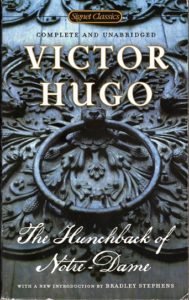Book Review: The Hunchback of Notre Dame by Victor Hugo
The Year of Grace 1482 is going to be the big one for Pierre Gringoire; he just knows it! The poet, philosopher and would-be playwright is debuting his new mystery play for the Cardinal of Bourbon and the Flemish ambassadors on January 6th, the Day of Kings and Feast of Fools. A good reception will net him rich rewards and fame.
Poor Gringoire! First, the important guests are delayed coming to the Hall of Justice, and the audience nearly riots to get the play started on time. Then a cheeky beggar heckles the audience for spare change. Then the Cardinal and crew finally arrive, drawing all attention from the stage. The Flemish ambassador pans the performance, and starts the election of the Pope of Fools. And the few audience members left are drawn away by the mysterious La Esmeralda!
Gringoire is in for even more suffering tonight, but he is not the fellow the book is named for, but just one of the many characters who live near the Cathedral of Notre Dame in Paris.
Victor Hugo wrote two great novels that still inspire adaptations today; Les Misérables and Notre-Dame de Paris. The latter got a title change in English to focus on the most memorable character. Quasimodo isn’t the protagonist either; the closest to a central character is La Esmeralda (“the Emerald”, named after her necklace), the beautiful dancer and goat trainer. All the important male characters are defined by their relationship to her.
The 15th-Century date seems significant, a decade before the discovery of the New World would change everything, and so the characters behave as though the Old World will always be.
It’s interesting to me how the changing fashions in literature affect some of Victor Hugo’s story beats. In the Nineteenth Century, the tall, brave and handsome warrior on a horse was almost invariably the hero of books, while a deformed or disabled or ethnic minority character (Quasimodo is apparently Roma by birth) is cast in a villainous role. The partial reversal of roles between Phoebus (who is only interested in La Esmeralda for sex) and Quasimodo (who defends La Esmeralda even though it’s clear she is revolted by him) was shocking at the time. Nowadays, there’s more variation in who gets to be the hero of stories.
And then there’s Frollo, the Archdeacon of Notre Dame and very much the villain of the story. A teen genius and rising star in the religious hierarchy, he loved his little brother Jehan and had good intentions when he adopted Quasimodo. Claude Frollo was a loving (if excessively stern) adoptive father to Quasimodo, and the local expert on alchemy. Until he saw La Esmeralda dance, and for the first time had sexual feelings he could not pray away.
With no experience of how to deal with women, and bound by a rigid set of personal and religious codes, Frollo chose to interpret the girl’s effect on him as witchcraft, and began the rapid mental decline that ends with him seeing La Esmeralda hang rather than be with anyone else.
Between this book and Les Miz, I get the distinct feeling that Victor Hugo was not a fan of the French legal system. Every time a character comes up against the courts and law enforcement, injustice is what ensues. This is most symbolized by the auditor (assistant judge) who is deaf, and cannot hear that Quasimodo (who is also mostly deaf) isn’t responding to his questions. He condemns the bellringer based on what he imagines Quasimodo might have said, and increases the punishment when someone tries to convey the truth to him.
The representation of Quasimodo as a person with disabilities is pretty good for the time when the novel was written. I can’t say the same for the representation of the Roma people, called “Gypsies” or “Egyptians” here. They’re depicted as a thieving, superstitious lot who hang out with the other worst elements of society. Part of establishing La Esmeralda as a good person is the reveal that she’s adopted. (As part of the “stolen by gypsies” myth.)
Mr. Hugo often takes the opportunity to spend a chapter talking about architecture, geography or how technology changes culture. This can be fascinating, but may irritate people who just want to get on with the story. He also uses some contrived coincidences to move the tale along. (In particular, one moment towards the end of the book would in a normal melodrama have been the end of Frollo’s scheme and La Esmeralda’s triumph. But it is ultimately useless.)
Definitely worth reading if you’ve liked any of the movies and are ready for more moral complexity.
Here’s a bit from the 1939 Charles Laughton film:

